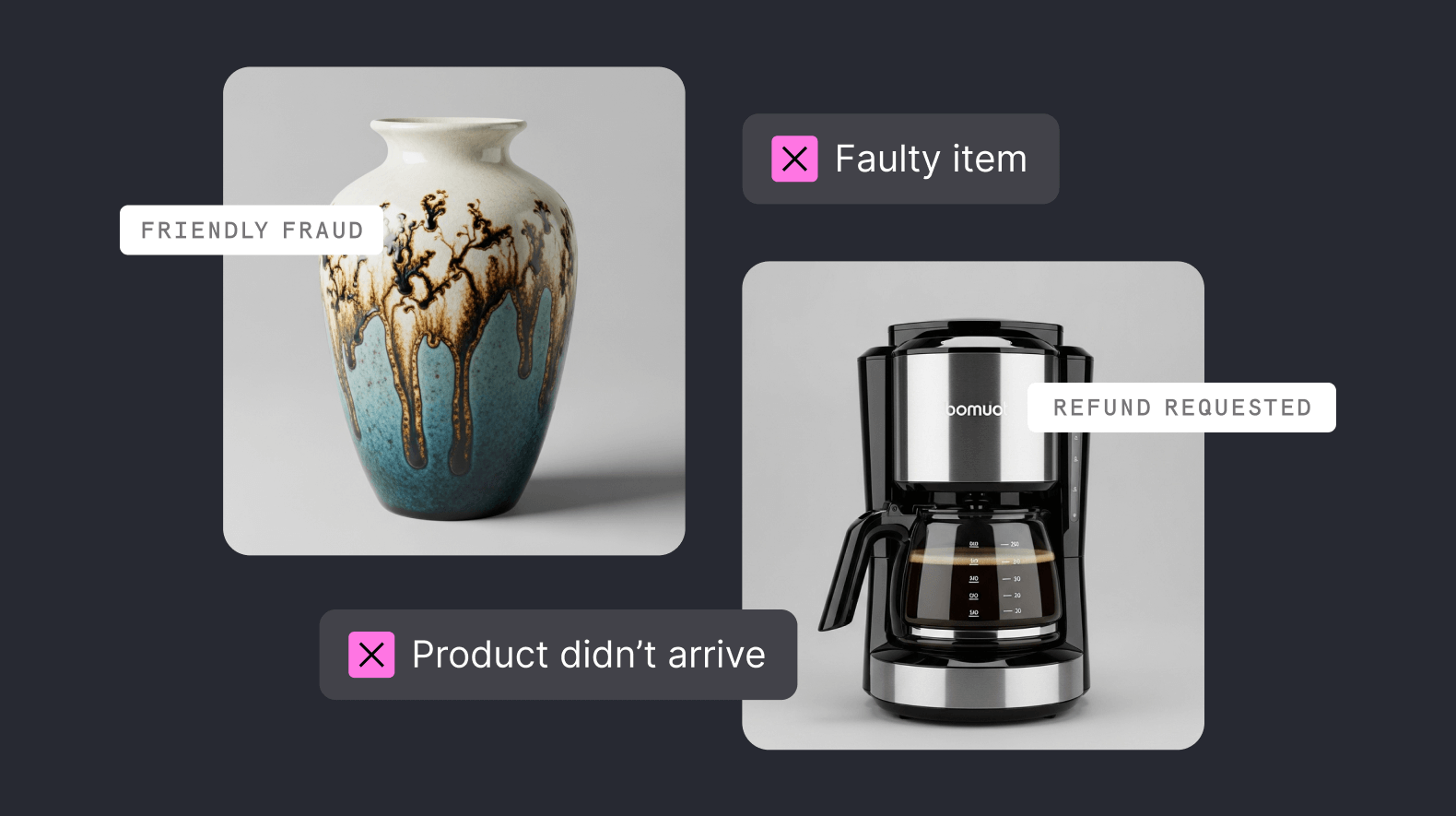When it comes to scams in cyberspace, technological innovation moves at lightspeed. Keeping up to date on the latest in payment fraud is critical for managing profit and loss. With merchants predicted to lose $91 billion from online payment fraud in 2028, now is the time to study up on fraud prevention.
On average, 3% of orders accepted in the past 12 months turned out to be fraudulent. However, you are not defenseless. By looking at the weaknesses in your payment protocols and online security, you can make targeted investments that prevent fraud.
This article draws out the latest payment fraud trends, and shows you how to combat some of the main types.
Summary of payment fraud trends
Fraud is particularly common in the world of online shopping, or ecommerce, as it’s known. An estimated 3.2% of total annual ecommerce revenue is lost to payment fraud each year, per the Merchant Risk Council (MRC).
While a decent amount of payment fraud involves stolen payment credentials, a growing proportion actually stems from individuals claiming their money back after a legitimate transaction. Roughly half (48%) of ecommerce merchants experienced refund/policy abuse in 2023 – in fact, it was the most common type of fraud mentioned. We’ll explain more on the hows, whats, and whys of this in more detail, below.
The trend of post-purchase consumer fraud – where a buyer initiates a wrongful request for a refund – means merchants not only need effective fraud prevention tools, but should also carefully review processes for returns and refunds.
Checkout.com has partnered with the MRC to provide online education on the essentials of fraud. It’s aimed at helping business professionals in the ecommerce industry gain awareness of the latest fraud trends.

Trend #1: First-party misuse is weighing on merchants’ minds (and profit margins)
- 62% of merchants report that first-party misuse rose by at least 5% in the past 12 months.
- Over one third of merchants (38%) reported a 5-25% increase in first-party misuse over 2024, compared with 25% of merchants surveyed in 2023.
- Two in five (41%) merchants named "improving payment/refund policies (for example, refund management)" as a main area for improvement to manage ecommerce fraud in 2023.
First-party fraud takes many forms, but it always refers to a buyer who misrepresents their own situation for financial gain. Examples include friendly fraud and chargeback fraud. It’s distinct from third-party payment fraud, which typically involves a criminal stealing credit card details and using them to make purchases. Instead, first-party fraud involves a customer making a claim on funds (or goods or services) related to their own actions, or the actions of the merchant towards the customer.
Ironically, this often involves a buyer claiming that a purchase they made was actually not authorized, but instead carried out by a criminal using their stolen payment details. In other instances, a consumer may inform the merchant that they never received the item they ordered (and paid for).
As such, first-party fraud can be quite complicated to resolve. With online merchants operating at a distance from their buyers, it can be resource-intensive to investigate claims that a customer deserves to receive replacement goods or a refund. There is a critical balance to strike between preserving the merchant-customer relationship, maintaining brand reputation, and avoiding devastating harm to profitability.
In a Checkout.com survey at MRC Vegas 2025, merchants identified returns fraud as a concern that’s top-of-mind this year. This echoed the results of a larger survey of ecommerce merchants in 2024, where around half of merchants named refund/policy abuse as the most common type of fraud. I’ll explain this in more detail, below.
Returns fraud
Returns fraud is when consumers exploit your returns policy for their own gain. It’s a form of refund abuse because buyers are attempting to use the refund policy in an unfair way.
Such difficulties occur as competitive businesses try to offer the best possible customer service to win and retain buyers. However, some buyers deliberately take advantage of loopholes – and cause financial damage to the business.
In a global survey of 18,000 consumers conducted by YouGov on behalf of Checkout.com, 13% agreed with the statement: “I believe I could get away with initiating a chargeback or refund on an online payment to receive goods/services free of charge”.
This attitude is translating into real harm for online sellers. Over half of merchants (57%) saw more refund/policy abuse in 2024, according to the MRC’s 2025 report. There’s a slight increase in merchants believing customers are initiating payment disputes (the first stage of a chargeback) to attempt to gain free goods or services. The reason behind this may be that customers are learning to “game the system”, plus the ease with which a customer can trigger a payment dispute.
How to fight returns fraud
To combat this, you should monitor transaction patterns and flag returns which hit your defined criteria for suspicious activity. Depending on your payment systems, you may be able to set up automation to detect if the same customer is routinely returning high-value items, regularly claiming to be a victim of payment fraud, or seemingly abusing your refund policy. You should consider how you can adapt your refund policy, and then clearly explain this on your website or app.
For instance, online fashion retailer ASOS introduced a “Fair Use Policy” which states it will not refund suspected fraudulent return attempts. For example, if items are returned that do not match what was ordered – an action which the company states it may take legal action against. An increasingly common type of returns fraud is where a buyer initiates a refund on an expensive purchase, but actually sends an item of low value (or an empty box) back to the merchant. This is another clear example of the importance of focusing on your “reverse logistics”, namely, ensuring that parcel weights are tracked, and warehouse operations are filmed (if the cost of such loss prevention outweighs the value of losses from returns fraud).
Another concern for fashion retailers is the practice of “wardrobing” where a consumer buys an item, wears it, and then returns it to try and get a refund. The problem, of course, is that the item may be dirty or otherwise damaged. Another customer would not be happy to receive the same item in such a condition. Not to mention that the merchant has lost money on the cost of customer acquisition, the fees for the payments (purchase and refund), as well as the delivery and handling costs.
To combat this problem, ASOS states on its website: “If an item is returned to us damaged, worn or in an unsuitable condition, we won't be able to give you a refund and we may have to send it back to you (and ask you to cover the delivery costs)”. This helps to clarify to customers what their responsibilities are, and provides customer service representatives with a valid reason for rejecting refund requests.
Trend #2: Payment fraud losses are becoming more costly
- The value of consumer payment fraud losses reported to the US Federal Trade Commission increased 305% between Q1 2020 and Q2 2024.
- Financial damage reported by Japanese companies due to credit card fraud surged 119% between 2020 and 2024, according to the Japanese Consumer Credit Association.
- Worldwide, the total amount lost to online payment fraud rose to $41bn in 2022, up from $17.5bn in 2020.
A range of sources confirm that the value of losses to payment fraud around the world is growing over time. The total amount lost to card fraud (including credit card fraud and debit card fraud) worldwide hit $33.83bn in 2023, amounting to a 19% increase since 2020.
This shows that the right time to invest in fraud prevention could be sooner rather than later. To figure out whether such investments are right for your business, you should conduct your own detailed analysis on the costs of fraud within your business.
Trend #3: The number of different types of fraud is increasing – and AI is helping
- Two thirds of merchants (66%) are either currently using or plan to use generative AI in ecommerce fraud management in the next 12 months.
- Over half (55%) of senior payment professionals named accelerated integration of AI and machine learning in payment processing and fraud detection as a top payment industry trend in 2024.
As well as experiencing fraud more often, merchants are also seeing an increase in the number of payment fraud types. This is confirmed by 2024 research from European Central Bank (ECB) and the European Banking Authority (EBA), which found that fraud levels remain high due to emerging new fraud types.
With the emergence of innovative technologies such as advanced generative AI, there are newer, more efficient ways to carry out fraud at scale. However, that does not leave merchants powerless. There are ways to use artificial intelligence to detect and block fraud, too.
Indeed, 85% of senior payments professionals feel that the best use case for AI is fraud detection and prevention. This stands to reason, as the algorithms underpinning machine-learning fraud detection tools can adapt to new types of fraudulent activity faster than any individual human could.
The London Stock Exchange identifies the use of emerging technologies to create new fraud strategies as a key trend for 2025. This could include convincing ways of deceiving authentication protocols, such as voice spoofing or deepfakes. Merchants need to remain aware of the possible weak points of account access procedures, which could permit fraudsters to break using AI.
As businesses are facing new varieties of fraudulent activities, awareness and education is more important than ever. Indeed, over a third (38%) of merchants named identifying and responding to new types of fraud attacks as the greatest challenge in managing ecommerce fraud in 2024.
Fight fraud and win consumer trust with Checkout.com
Understanding emerging fraud trends and implementing effective prevention strategies is the first step in protecting your business.
At Checkout.com, we’re committed to helping the next generation of payment professionals navigate the evolving fraud landscape. That’s why we’re proud to sponsor the Merchant Risk Council’s (MRC) Fraud Essentials course – an on-demand resource that equips your people with the knowledge to combat fraud.
This complimentary course will help you safeguard your business from financial loss and reputational damage, while protecting brand reputation and gaining customer trust, too.
We know consumers feel reassured when merchants take proactive steps to manage their payment details responsibly. An encouraging 64% of online shoppers say they’re more likely to buy from businesses that securely store their payment details. This is good evidence to support investment in payment data security, as it helps to strengthen sales and build customer loyalty.
Our in-house fraud teams are constantly researching sophisticated techniques in the fight against fraud. We apply our findings to our fraud prevention tools in response to the latest trends in fraud. Using a combination of machine learning, customizable fraud rules, and automated dispute resolution, our payments experts ensure your business thrives.
Learn more about Fraud Detection Pro, the sophisticated fraud blocking engine for your payments.







.png)
.png)




.png)

_conversion%20tactics.png)
